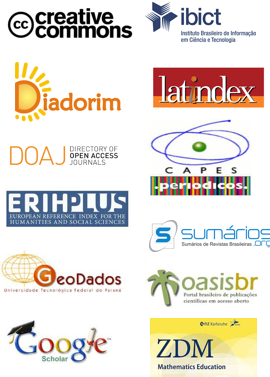Apreensão Operatória de Figuras em Situações Geométricas
DOI:
https://doi.org/10.17921/2176-5634.2019v12n3p245-257Resumo
De grande importância para o estudo da Geometria são as figuras. O principal motivo é que na resolução de um problema, tais representações
permitem, em geral, um acesso mais direto aos objetos da situação e menos custoso que um texto. Mas, muitas vezes, para resolver um
problema, é necessário transformar ou modificar uma dada figura em outras, a fim de obter novos elementos que poderão levar à ideia de sua
solução ou de uma prova. Essa capacidade de modificar uma figura envolve o que R. Duval denomina apreensão operatória da figura. Um
tipo de modificação consiste na divisão da figura em outras subfiguras que podem ser reagrupadas para formar novas figuras. A capacidade
de modificar uma figura de partida para visualizar a resolução de um problema pode ser desenvolvida e deve ser estimulada pelo professor no
ensino da Matemática, em particular na Geometria. Nesse artigo, com base nos trabalhos do referido autor, apresentamos exemplos específicos
que caracterizam e destacam o papel e a importância da apreensão operatória para analisar o funcionamento de uma figura na abordagem de
uma situação geométrica por um sujeito. E ainda, introduzimos constructos teóricos da abordagem semiótica, a fim de realçar as possíveis
influências de ambientes de Geometria Dinâmica em processos de visualização e nas representações que estudantes podem construir de
conceitos e problemas geométricos nesses ambientes.
Palavras-chave: Geometria. Figuras. Apreensão Operatória. Visualização.
Abstract
Figures assume an important role in the study of Geometry. It should be emphasized, as the main reason, that such representations allow more
direct access to objects of the problems, richer and less expensive than texts. Nevertheless, the figure can be seen by students, differently from
what a teacher sees. Often, transforming or modifying figures in other ones is a helpful approach, and necessary to obtain new elements that
may lead to the idea of a problem solution or proof. This ability to modify a figure refers to an operative apprehension of the figure. It can
be mentioned that one important type of modification consists of dividing the figure into other sub figures that can be regrouped to form new
shapes. The ability to modify a starting figure to visualize the solution of a problem can be developed and should be stimulated by the teacher
in the teaching of Mathematics, in Geometry. This text presents and highlights the role and importance of the operative apprehension of figures
based on specific examples.
Keywords: Geometry. Figures. Operative Apprehension. Visualization.
Referências
Acuña, C. (2010). Gestalt configurations in Geometry learning. In V. Durand-Guerrier, S. Soury-Lavergne & F. Arzarello (Eds.), Proceedings of CERME 6 (pp. 706-715), January 28th-February 1st 2009. Lyon, France: INRP.
Brousseau, G. (2002) Theory of Didactical Situations in Mathematics. London: Kluwer Academic Publishers.
Duval R. (1994). Les différents fonctionnements d’une figure dans une démarche géométrique. Repères IREM, 17, 121-138.
Duval, R. (1995a) Geometrical Pictures: Kinds of representation and specific processing. In R. Sutherland and J. Mason (eds.), Exploiting Mental Imagery with Computers in Mathematics Education (pp. 142–157). Berlin: Springer.
Duval, R. (1995b). Sémiosis et pensée humaine. Berne: Peter Lang.
Duval, R. (1998), Geometry from a cognitive point a view. In C. Mammana and V. Villani (eds.), Perspectives on the Teaching of Geometry for the 21st Century (pp. 37–52). Dordrecht: Kluwer Academic Publishers.
Duval, R. (2006). A cognitive analysis of problems of comprehension in a learning of mathematics. Educational Studies in Mathematics, 61, 103–131, DOI: 10.1007/s10649-006-0400-z.
Duval, R. (2012a) Registros de representação semiótica e funcionamento cognitivo do pensamento. Tradução: Méricles Thadeu Moretti. Revemat – Revista Eletrônica de Educação Matemática, 7(2), 266-297. DOI: https://doi.org/10.5007/1981-1322.2012v7n2p266.
Duval, R. (2012b). Abordagem cognitiva de problemas de geometria em termos de congruência. Tradução: Méricles Thadeu Moretti. Revemat – Revista Eletrônica de Educação Matemática, 7(1), 118-138.
Fischbein, E. (1993). The theory of figural concepts, Educational Studies in Mathematics. 24, 139-162.
Hoffman, D (1998). Visual intelligence: How we create what we see. New York/NY: W. W. Norton & Company, Inc.
Jahn. A.P. (2002) “Locus” and “Trace” in Cabri-géomètre: relationships between geometric and functional aspects in a study of transformations, ZDM, 34(3), 78-84.
Janela, M. A. C. P. (2012). O (novo) programa de Matemática do Ensino Básico e o desenvolvimento do raciocínio geométrico no tópico triângulos e quadriláteros: um estudo em turmas piloto do 7.º ano. Tese de mestrado, Educação (Didáctica da Matemática), Universidade de Lisboa, Instituto de Educação.
Laborde C. (2005). The Hidden Role of Diagrams in Students’ Construction of Meaning in Geometry. In: J. Kilpatrick, C. Hoyle, O. Skovsmose, P. Valero (eds.) Meaning in Mathematics Education (pp. 159-179). New York, NY: Springer. DOI: https://doi.org/10.1007/0-387-24040-3_11
Matos, J. M. & Gordo, M. F. (1993). Visualização espacial: algumas actividades. Educação e Matemática, 26, 13-17.
Pyke (2003). The use of Symbols, Words, and Diagrams as indicators of Mathematical Cognition: A Causal Model. Journal for research in mathematics education, 34(5), 406-432.


